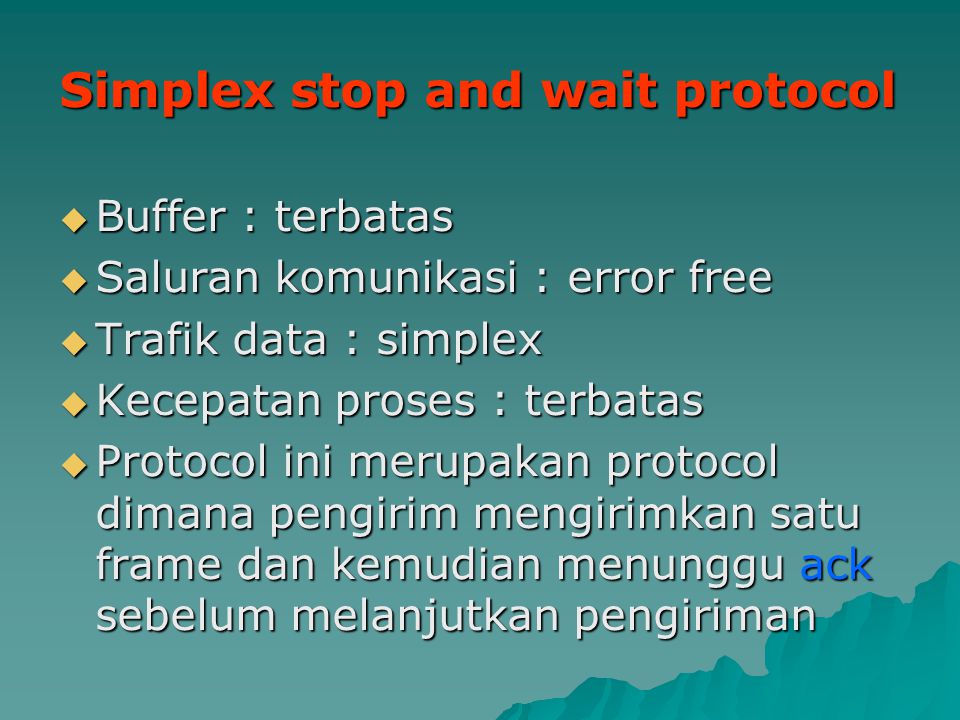What is Simplex Stop Protocol?
The Stop and Wait Protocol is a simple protocol used in communication networks to manage the flow of data between devices. It is commonly used in serial communication systems, where data is transmitted one bit at a time over a single channel.
The basic idea behind the Stop and Wait Protocol is that the sender sends a bit of data, then waits for an acknowledgement from the receiver before sending the next bit. If the receiver receives a bit without error, it sends an acknowledgement signal back to the sender. If the receiver detects an error, it sends a negative acknowledgement signal (NAK) back to the sender.
Here’s how the protocol works:
- The sender starts by sending a bit of data.
- The receiver checks the received bit for errors. If there is no error, it sends an acknowledgement signal (ACK) back to the sender.
- The sender waits for the acknowledgement signal from the receiver before sending the next bit.
- If the receiver detects an error, it sends a NAK signal back to the sender.
- The sender receives the NAK signal and retransmits the previous bit.
- Steps 2-5 are repeated until the sender successfully transmits all bits.
The Stop and Wait Protocol is simple to implement and can handle errors effectively. However, it has some limitations. For example, if the channel is slow or noisy, the transmission rate may be low due to the need to wait for acknowledgements after each bit. Additionally, if multiple errors occur in a row, the protocol may repeatedly enter a loop of retransmitting the same bit, leading to reduced efficiency.
Despite these limitations, the Stop and Wait Protocol remains widely used in various applications, such as modems, digital cameras, and other serial communication systems.
What is the stop-and-wait protocol used for?
The Stop-and-Wait Protocol is a simple and fundamental flow control mechanism used in data communication and networking to ensure reliable transmission of data between two entities, typically a sender and a receiver. It is often employed in scenarios where the communication channel or medium is prone to errors, such as in point-to-point communication links like serial connections or wireless links.
The primary purpose of the Stop-and-Wait Protocol is to ensure that data is transmitted accurately and without loss or corruption. It operates as follows:
- Sender (Transmitter): The sender sends a data frame to the receiver.
- Receiver: Upon receiving the data frame, the receiver sends an acknowledgement (ACK) back to the sender to confirm the successful receipt of the frame.
- Sender (Transmitter): If the sender receives the ACK within a specified time, it knows that the frame was successfully received and can proceed to send the next frame.
- Receiver: If the receiver detects an error in the received frame, it returns a negative acknowledgement (NAK) to the sender, indicating that the frame was corrupted.
- Sender (Transmitter): The sender retransmits the same data frame upon receiving a NAK or not receiving an ACK within the timeout period.
- Receiver: The receiver processes the frame upon successful receipt, discarding duplicate frames.
The Stop-and-Wait Protocol ensures that the sender does not overwhelm the receiver with an excessive amount of data, allowing the receiver to process each frame and provide feedback before the next frame is sent. This protocol is simple to implement but can be inefficient, especially over long communication delays or when there’s a significant possibility of data errors.
More advanced protocols, such as the sliding window protocols (e.g., Go-Back-N and Selective Repeat), have been developed to improve efficiency and throughput in data communication by allowing the sender to transmit multiple frames before waiting for individual acknowledgements.
This protocol also provides for a one-directional data flow from sender to receiver. The communication channel is once again assumed to be error-free, as in Unrestricted Simplex Protocol. However, in this case, the receiver has only a finite buffer capacity and a finite processing speed, so the protocol must explicitly prevent the sender from flooding the receiver with data faster than it can be handled.
The main problem that has to deal with here is how to prevent the sender from flooding the receiver with data faster than the receiver can process it. One solution to this problem is that if the receiver requires a time delta t, to execute from_Physical_Layer plus to_Network_Layer, the sender must transmit at an average rate of less than one frame per time delta t.
A more general solution to this problem is to have the receiver provide feedback to the sender. After having passed its packet to its Network Layer, the receiver sends a little dummy frame back to the sender, giving the sender permission to transmit the next frame. After sending a frame, the protocol requires the sender to bide (restrict) its time until a little dummy frame arrives.
The protocol in which the sender sends one frame and waits for the acknowledgement before proceeding is called Stop_and_Wait. The sender starts by fetching a packet from the Network Layer, using it to construct a frame and sending it all its way, and then the sender must wait until an acknowledgement frame arrives before looping back and fetching the next packet from Network Layer.

